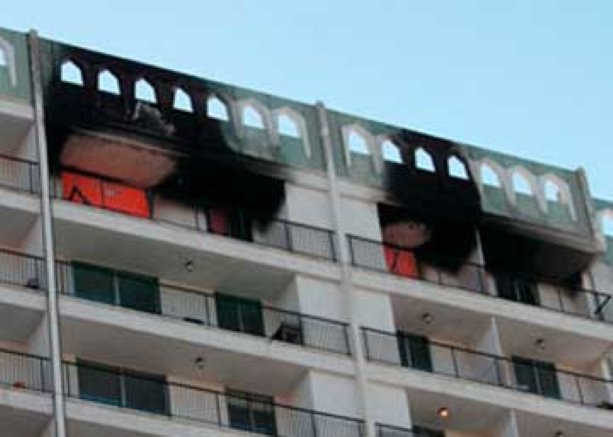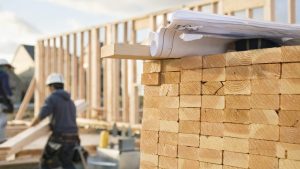Repairs are underway on a downtown Edmonton high-rise, after a fire left hundreds of residents looking for a place to stay.
Environmental Remediation
Repairs are underway on a downtown Edmonton high-rise, after a fire left hundreds of residents looking for a place to stay.
A number of units in the Valhalla condominium on 99 Avenue were damaged by water, when firefighters contained a fire on Nov. 23. The repairs to the 40-year old building are being complicated by asbestos, which was discovered in the drywall during the fire inspection.
It is anticipated that four to six months will be needed to remove the asbestos and repair the damages.
Rod Hall, owner of RH Services Inc., a consulting company that specializes in asbestos management, said finding asbestos in older buildings is a common occurrence. However, finding the toxic substance is more difficult.
“Everyone thinks they know what asbestos is,” Hall said.
“They’ve heard of it and they know it’s bad, but when you actually start saying, ‘Where is it?’ they don’t really know
Hall said There is a list of things he looks for when called in to detect the presence of asbestos.
“Our training and experience over the years allows us to be able to come in and say, ‘Look, that material could be asbestos,” he said.
When a material is suspected of containing asbestos, lab analysis using polarized light microscopy is undertaken.
“Mineralogy is what it is,” Hall explained of the process. “Asbestos is a very special mineral because it’s fibrous. It has a very distinct way of determining what it is by using polarized light.”
A geological approach called the NIOSH (National Institute for Occupational Health and Safety) 9002 method, is used to identify the fibrous mineral. Once the presence of asbestos is confirmed, it must be removed prior to any work being done on the renovation.
“What you don’t want to do is have guys coming into the building doing renovation and running into this material,” he said, adding exposure usually results in the job site being shut down.
Asbestos removal falls into low, moderate and high risk categories, each requiring different levels of care. The removal of vinyl asbestos tiles is considered low risk, because the asbestos is well bonded within the tiles. High risk asbestos removal is more complex. It requires contamination chambers with clean rooms and dirty rooms, as well as showers.
“You’ve got guys that have to go into this area that’s completely air tight and put under a negative pressure with special machines that are HEPA (High Efficiency Particulate Air) filtered,” said Hall. “They do the work in that environment so that the surrounding environment isn’t contaminated.” The Alberta Asbestos Abatement Manual, published by Alberta Employment and Immigration’s Workplace Health and Safety Division sets out the guidelines for how asbestos is to be dealt with, depending on the scope of the project.
In buildings that are being altered or renovated, asbestos-containing materials that have a risk of releasing fibres into the air must be encapsulated, enclosed or removed. Encapsulation involves the coating of asbestos-containing materials with a bonding agent. Enclosure involves separating the asbestos materials from the surrounding building environment using barriers.
But regardless of the project, Occupational Health and Safety is to be notified whenever asbestos is involved, particularly if the building is to be taken down. “Anytime there’s asbestos in a building that’s being demolished, Occupational Health and Safety must be notified by the contractor who’s working on the abatement of that asbestos,” said Barrie Harrison, a spokesperson with Alberta Employment and Immigration. “Our law, under Occupational Health and Safety, suggests the asbestos must be removed prior to demolition.
There are some exceptions. Sometimes if the asbestos is too difficult to reach, too difficult to abate, other mechanisms have to be put in place to ensure the safety of the workers who are working with that product.”
Harrison said the alternative mechanisms can vary depending on the type of asbestos being worked with, but can include keeping the material wet to prevent the fibres from becoming airborne. But even in buildings where no renovations are scheduled, the province’s manual calls for owners to have an asbestos management plan if asbestos-containing materials are present.
Hall said few building owners have a management plan in place and that many of his calls come when the presence of asbestos has created a problem with work going forward. The consultant said there is a misconception that asbestos is fine so long as it is not disturbed, prompting many building owners to deal with the materials reactively rather than proactively. Hall said it is important to have a plan in place should the material become disturbed. An asbestos-containing ceiling could suddenly become a problem should a gradual roof leak cause part of the ceiling to drop, releasing fibres into the air.
“The management plan is absolutely the critical thing to have,” Hall said. “And without that, you can not hope to control asbestos.”











Recent Comments
comments for this post are closed